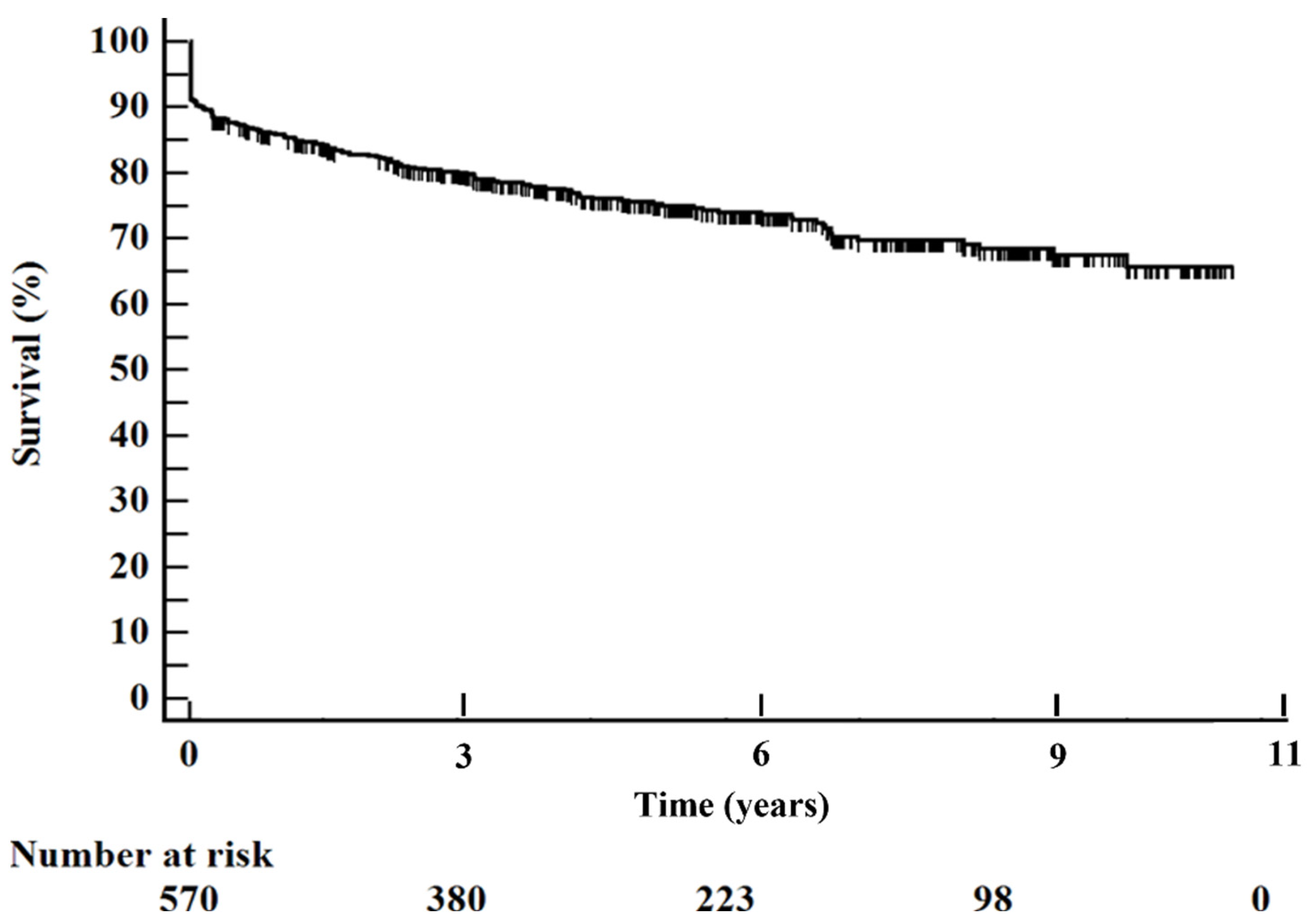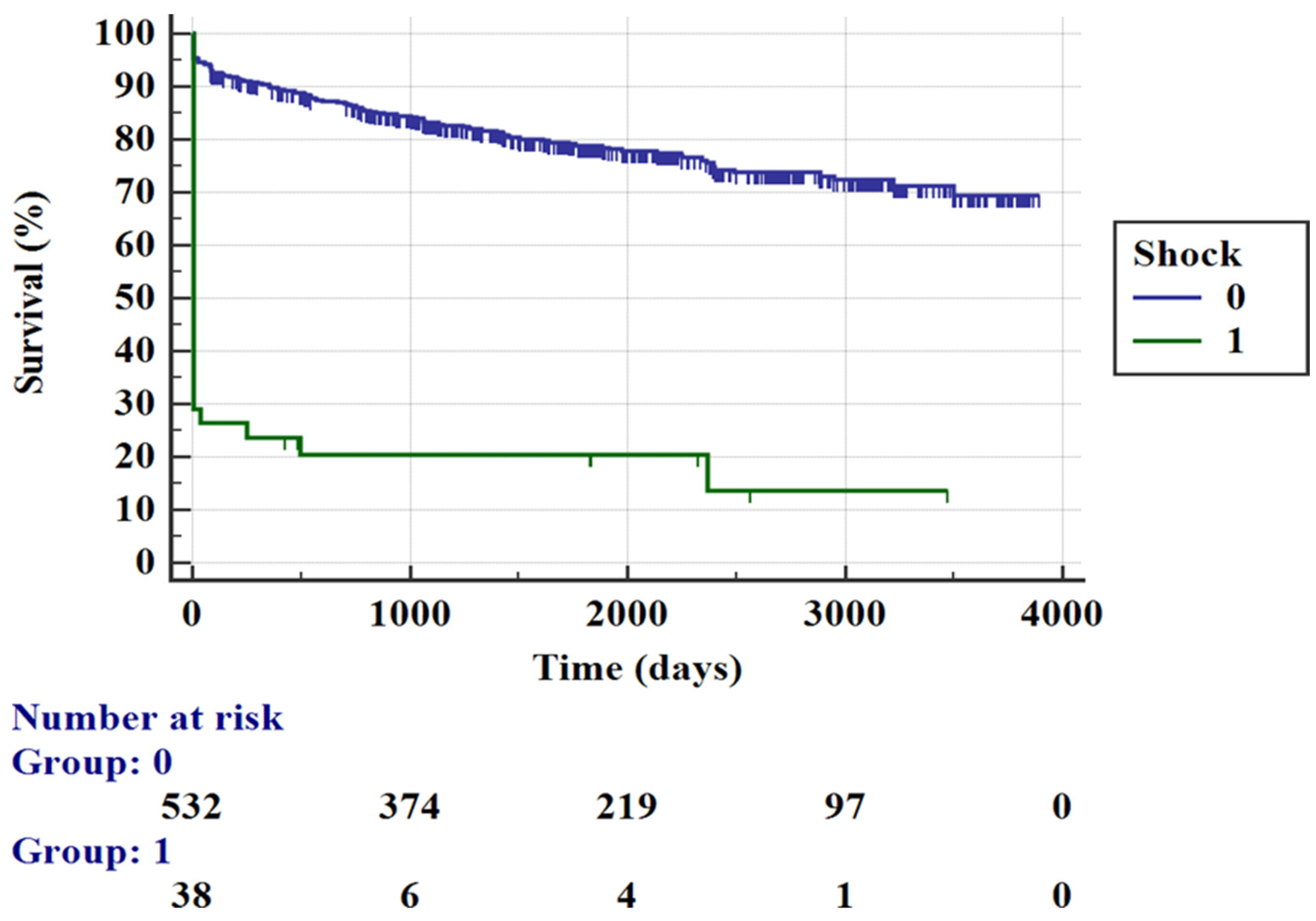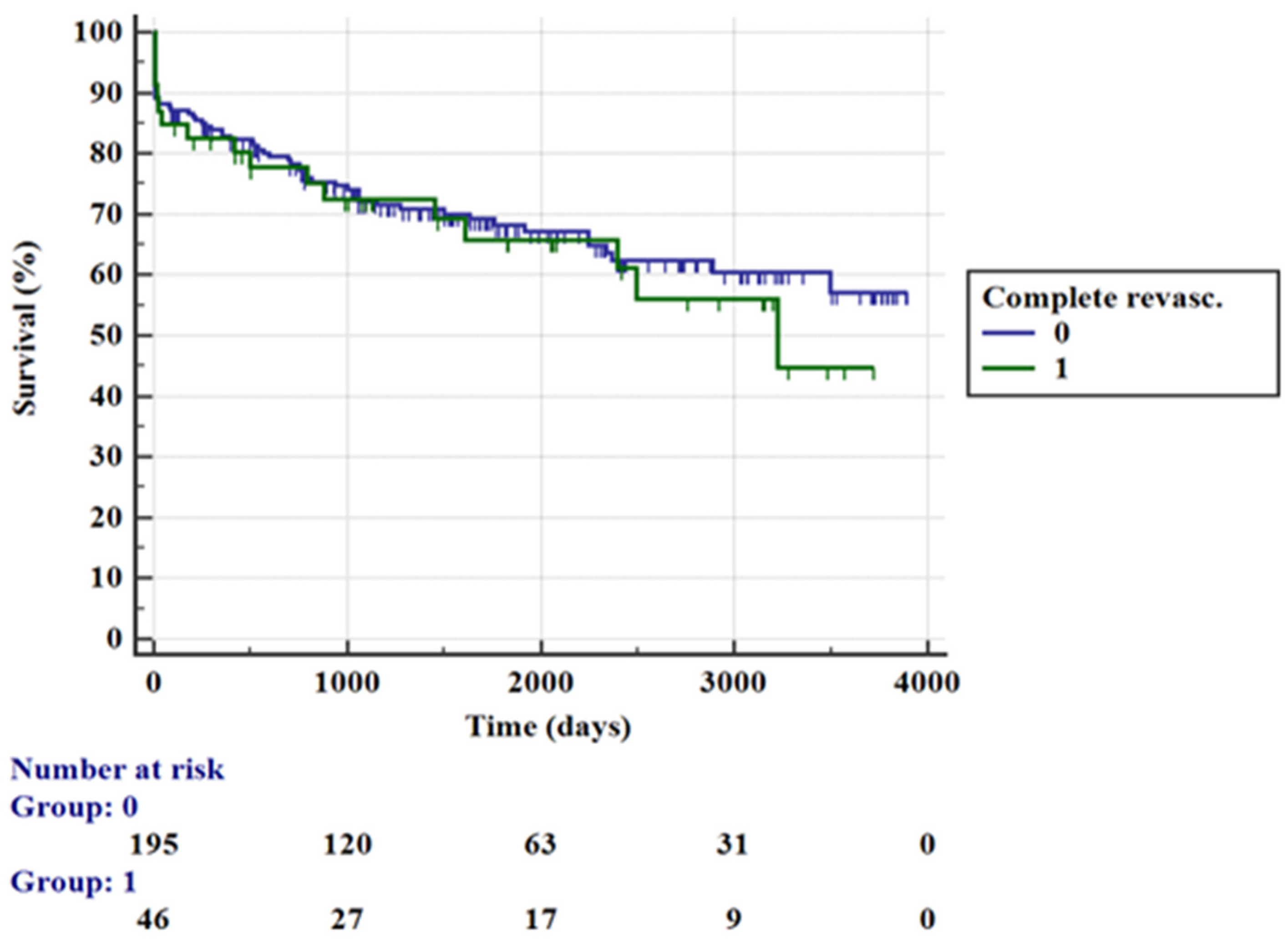Predictors of Mortality and Long-Term Outcome in Patients with Anterior STEMI: Results from a Single Center Study
Abstract
:1. Introduction
2. Materials and Methods
Statistical Analysis
3. Results
4. Discussion
Study Limitations
5. Conclusions
Author Contributions
Funding
Institutional Review Board Statement
Informed Consent Statement
Conflicts of Interest
References
- Gershlick, A.H.; Khan, J.N.; Kelly, D.J.; Greenwood, J.P.; Sasikaran, T.; Curzen, N.; Blackman, D.J.; Dalby, M.; Fairbrother, K.L.; Banya, W.; et al. Randomized trial of complete versus lesion-only revascularization in patients undergoing primary percutaneous coro-nary intervention for STEMI and multivessel disease: The CvLPRIT trial. J. Am. Coll. Cardiol. 2015, 65, 963–972. [Google Scholar] [CrossRef] [Green Version]
- Park, D.-W.; Clare, R.M.; Schulte, P.J.; Pieper, K.S.; Shaw, L.K.; Califf, R.M.; Ohman, E.M.; Van De Werf, F.; Hirji, S.; Harrington, R.A.; et al. Extent, location, and clinical significance of non-infarct related coronary artery disease among patients with ST-elevation myocardial infarction. JAMA 2014, 312, 2019–2027. [Google Scholar] [CrossRef]
- Sehti, A.; Bahekar, A.; Bhuriya, R.; Singh, S.; Ahmed, A.; Khosla, S. Complete versus culprit only revascularization in acute ST elevation myocardial infarction: A meta-analysis. Catheter. Cardiovasc. Interv. 2011, 77, 163–170. [Google Scholar]
- Hlinomaz, O.; Groch, L.; Polokova, K.; Lehar, F.; Vekov, T.; Petkov, R.; Stoynev, M.; Griva, M.; Sitar, J.; Rezek, M. Multivessel Coronary Disease Diagnosed at the Time of Primary PCI for STEMI: Complete Revascularization versus Conservative Strategy. PRAGUE 13 Trial. In EuroPCR 2015. Available online: https://media.pcronline.com/diapos/EuroPCR2015/2173-20150519_1445_Main_Arena_Hlinomaz_Ota_1111_(6859)/Hlinomaz_Ota_20150519_1445_Main_Arena.pdf (accessed on 17 April 2020).
- Kornowski, R.; Mehran, R.; Dangas, G.; Nikolsky, E.; Assali, A.; Claessen, B.E.; Gersh, B.J.; Wong, S.C.; Witzenbichler, B.; Guagliumi, G.; et al. Prognostic impact of staged versus “one-time” multivessel percutaneous intervention in acute myocardial infarction: Analysis from the HORIZONS-AMI (harmonizing outcomes with revascularization and stents in acute myocardial infarction) trial. J. Am. Coll. Cardiol. 2011, 58, 704–711. [Google Scholar] [CrossRef] [Green Version]
- Wald, D.S.; Morris, J.; Wald, N.J.; Chase, A.J.; Edwards, R.J.; Hughes, L.O.; Berry, C.; Oldroyd, K.G.; PRAMI Investigators. Randomized trial of Preventive Angioplasty in Myocardial Infarction. N. Engl. J. Med. 2013, 369, 1115–1123. [Google Scholar] [CrossRef] [Green Version]
- Di Mario, C.; Mara, S.; Flavio, A.; Imad, S.; Antonio, M.; Anna, P.; Emanuela, P.; Stefano, D.S.; Angelo, R.; Stefania, C.; et al. Single vs. multivessel treatment during primary angioplasty: Results of the multicentre randomised Hepacoat for Culprit or Multivessel Stenting for Acute Myocardial Infarction (HELP AMI) study. Int. J. Cardiovasc. Interv. 2004, 6, 128–133. [Google Scholar]
- Engstrom, T.; Kelbaek, H.; Helqvist, S.; Høfsten, D.E.; Kløvgaard, L.; Holmvang, L.; Jørgensen, E.; Pedersen, F.; Saunamäki, K.; Clemmensen, P.; et al. Complete revascularisation versus treatment of the culprit lesion only in patients with ST-segment elevation myocardial infarction and multivessel disease (DANAMI-3-PRIMULTI): An open-label, randomised controlled trial. Lancet 2015, 386, 665–671. [Google Scholar] [CrossRef]
- Moreno, R.; Mehta, S.R. Nonculprit vessel intervention: Let’s COMPLETE the evidence. Rev. Esp. Cardiol. Engl. Ed. 2017, 70, 418–420. [Google Scholar] [CrossRef]
- Bangalore, S.; Toklu, B.; Wetterslev, J. Complete versus culprit-only revasculariza-tion for ST-segment-elevation myocardial infarction and multivessel disease: A meta-analysis and trial sequential analysis of randomized trials. Circ. Cardiovasc. Interv. 2015, 8, e002142. [Google Scholar] [CrossRef] [Green Version]
- Elgendy, I.Y.; Mahmoud, A.N.; Kumbhani, D.J.; Bhatt, D.L.; Bavry, A.A. Complete or culprit-only revascularization for patients with multivessel coronary artery disease undergoing percutaneous coronary intervention: A pairwise and network meta-analysis of randomized trials. JACC Cardiovasc. Interv. 2017, 10, 315–324. [Google Scholar] [CrossRef]
- Mehta, S.R.; Wood, D.A.; Storey, R.F.; Mehran, R.; Bainey, K.R.; Nguyen, H.; Meeks, B.; Di Pasquale, G.; López-Sendón, J.; Faxon, D.P.; et al. Complete Trial Steering Commit-tee and Investigators. Complete revascularization with multivessel PCI for myocardial infarction. N. Engl. J. Med. 2019, 381, 1411–1421. [Google Scholar] [CrossRef] [Green Version]
- Sud, K.; Haddadin, F.; Tsutsui, R.S.; Parashar, A.; Bandyopadhyay, D.; Ellis, S.G.; Tuzcu, E.M.; Kapadia, S. Readmissions in ST-Elevation Myocardial Infarctionand Cardiogenic Shock (from Nationwide Readmission Database). Am. J. Cardiol. 2019, 124, 1841–1850. [Google Scholar] [CrossRef]
- Hochman, J.S.; Sleeper, L.A.; Webb, J.G.; Sanborn, T.A.; White, H.D.; Talley, J.D.; Buller, C.E.; Jacobs, A.K.; Slater, J.N.; Col, J.; et al. Early revascularization in acute myo-cardial infarction complicated by cardiogenic shock. SHOCK Investigators. Should We Emergently Revascularize Occluded Coronaries for Cardiogenic Shock. N. Engl. J. Med. 1999, 341, 625–634. [Google Scholar] [CrossRef] [PubMed] [Green Version]
- Prondzinsky, R.; Lemm, H.; Swyter, M.; Wegener, N.; Unverzagt, S.; Carter, J.M.; Russ, M.; Schlitt, A.; Buerke, U.; Christoph, A.; et al. Intra-aortic balloon counterpulsation in patients with acute myocardial infarction complicated by cardiogenic shock: The prospective, randomized IABP SHOCK Trial for attenuation of multiorgan dysfunction syndrome. Crit. Care Med. 2010, 38, 152–160. [Google Scholar] [CrossRef] [PubMed] [Green Version]
- Thiele, H.; Akin, I.; Sandri, M.; Fuernau, G.; De Waha, S.; Meyer-Saraei, R.; Nordbeck, P.; Geisler, T.; Landmesser, U.; Skurk, C.; et al. PCI Strategies in Patients with Acute Myocardial Infarction and Cardiogenic Shock. N. Engl. J. Med. 2017, 377, 2419–2432. [Google Scholar] [CrossRef] [Green Version]
- Thiele, H.; Zeymer, U.; Neumann, F.J.; Ferenc, M.; Olbrich, H.-G.; Hausleiter, J.; Richardt, G.; Hennersdorf, M.; Empen, K.; Fuernau, G.; et al. Intraaortic balloon support for myocardial infarction with cardiogenic shock. N. Engl. J. Med. 2012, 367, 1287–1296. [Google Scholar] [CrossRef] [Green Version]
- Levey, A.S.; Stevens, L.A.; Schmid, C.H.; Zhang, Y.; Castro, A.F.; Feldman, H.I.; Kusek, J.W.; Eggres, P.; Van Lente, F.; Greene, T.; et al. A new equation to estimate glomerular filtration rate. Ann. Intern. Med. 2009, 150, 604–612. [Google Scholar] [CrossRef] [PubMed]
- Thanavaro, S.; Kleiger, R.E.; Province, M.A.; Hubert, J.W.; Miller, J.P.; Krone, R.J.; Oliver, G.C. Effect of infarct location on the in-hospital prognosis of patients with first transmural myocardial infarction. Circulation 1982, 66, 742–747. [Google Scholar] [CrossRef] [PubMed] [Green Version]
- Hayiroglu, M.I.; Keskin, M.; Uzun, A.O.; Yıldırım, D.İ.; Kaya, A.; Çinier, G.; Bozbeyoğlu, E.; Yıldırımtürk, Ö.; Kozan, Ö.; Pehlivanoğlu, S. Predictors of in hospital mortality in patients with ST-segment elevation myocardial infarction complicated with cardiogenic shock. Heart Lung Circ. 2019, 28, 237–244. [Google Scholar] [CrossRef] [PubMed]
- Chehab, O.; Qannus, A.S.; Eldirani, M.; Hassan, H.; Tamim, H.; Dakik, H.A. Predictors of In-Hospital Mortality in Patients Admitted with Acute Myocardial Infarction in a Developing Country. Cardiol. Res. 2018, 9, 293–299. [Google Scholar] [CrossRef]
- Pfeffer, M.A.; Braunwald, E. Ventricular remodeling after myocardial infarction. Experimental observations and clinical implications. Circulation 1990, 81, 1161–1172. [Google Scholar] [CrossRef] [PubMed] [Green Version]
- Ponikowski, P.; Voors, A.A.; Anker, S.D.; Bueno, H.; Cleland, J.G.F.; Coats, A.J.S.; Falk, V.; González-Juanatey, J.R.; Harjola, V.-P.; Jankowska, E.A.; et al. 2016 ESC Guidelines for the diagnosis and treatment of acute and chronic heart failure: The Task Force for the diagnosis and treatment of acute and chronic heart failure of the European Society of Cardiology (ESC). Developed with the special contribution of the Heart Failure Association (HFA) of the ESC. Eur. J. Heart Fail 2016, 18, 891–975. [Google Scholar] [PubMed]
- Cretu, D.E.; Udroiu, C.A.; Stoicescu, C.I.; Tatu-Chitoiu, G.; Vinereanu, D. Predictors of in-Hospital Mortality of ST-Segment Elevation Myocardial Infarction Patients Undergoing Interventional Treatment. An Analysis of Data from the RO-STEMI Registry. Maedica J. Clin. Med. 2015, 10, 295–303. [Google Scholar]
- De la Espriella-Juan, R.; Valls-Serral, A.; Trejo-Velasco, B.; Berenguer-Jofresa, A.; Fabregat-Andrés, Ó.; Perdomo-Londoño, D.; Albiach-Montañana, C.; Vilar-Herrero, J.V.; Sanmiguel-Cervera, D.; Rumiz-Gonzalez, E.; et al. Impact of intra-aortic balloon pump on short-term clinical outcomes in ST-elevation myocardial infarction complicated by cardiogenic shock: A “real life” single center experience. Med. Intensiv. 2017, 41, 86–93. [Google Scholar] [CrossRef]
- Barron, H.V.; Every, N.R.; Parsons, L.S.; Angeja, B.; Goldberg, R.J.; Gore, J.M.; Chou, T.M.; Investigators in the National Registry of Myocardial Infarction 2. The use of intra-aortic balloon counterpulsation in patients with cardiogenic shock complicating acute myocardial infarction: Data from the National Registry of Myocardial Infarction 2. Am. Heart J. 2001, 141, 933–939. [Google Scholar] [CrossRef] [PubMed] [Green Version]



| Baseline Clinical Characteristics | ||||
|---|---|---|---|---|
| Whole Population (n = 584) | Survival (n = 423) | Non-Survival (n = 161) | p Value | |
| Age (M-SD) | 66.2 +/− 13.6 | 62.5 +/− 12.2 | 77.5 +/− 10.8 | <0.001 |
| Male gender (%) | 70.7 | 75.6 | 56.8 | <0.001 |
| Anemia (%) | 20.3 | 18.2 | 26.4 | <0.001 |
| Renal function | <0.001 | |||
| eGFR > 90 mL/min/1.73 mq (%) | 38.8 | 45.5 | 18.2 | |
| 90 < eGFR < 60 mL/min/1.73 mq (%) | 38.4 | 40.8 | 33.6 | |
| 60 < eGFR < 30 mL/min/1.73 mq (%) | 17.7 | 11.8 | 35 | |
| 30 < eGFR< 15 mL/min/1.73 mq (%) | 2.3 | 1 | 6.3 | |
| eGFR < 15 mL/min/1.73 mq (%) | 2.6 | 1 | 7 | |
| Diabetes (%) | 18.2 | 16.4 | 23 | Ns |
| Hypertension (%) | 49.7 | 46.7 | 58.8 | 0.04 |
| Family history of CAD (%) | 13.7 | 16.8 | 4.1 | <0.001 |
| Active smoke (%) | 38 | 44.1 | 21.2 | <0.001 |
| Previous smoke (%) | 2.4 | 2.8 | 1.4 | <0.001 |
| Dyslipidemia (%) | 31.2 | 32.2 | 27 | Ns |
| Overweight (%) | 10.6 | 11.6 | 6.8 | Ns |
| Ejection fraction (M-SD) | 45.1 +/− 11 | 46.9 +/− 9.7 | 38.7 +/− 12.6 | <0.001 |
| History of CAD (%) | 5.1 | 4.7 | 6.1 | Ns |
| Killip class (%) | <0.001 | |||
| Killip class 1 | 83.4 | 91 | 60.8 | |
| Killip class 2 | 5.1 | 4.7 | 6.8 | |
| Killip class 3 | 5 | 2.6 | 11.5 | |
| Cardiogenic shock at presentation (%) | 6.5 | 1.7 | 20.9 | |
| Cardiac arrest (%) | 3.3 | 1.7 | 7.4 | <0.001 |
| Haemoglobin (g/dL) (M-SD) | 13.9 +/− 2 | 14.3 +/− 1.7 | 12.8 +/− 2.1 | <0.001 |
| Serum Creatinine (mg/dL) (M-SD) | 1.08 +/− 0.81 | 0.97 +/− 0.6 | 1.37 +/− 1.08 | <0.001 |
| eGFR (mL/min/m2) (M-SD) | 78.2 +/− 25.7 | 83.9 +/− 22.1 | 65.5 +/− 28.1 | <0.001 |
| Procedural characteristics | ||||
| CAD extension | ||||
| One vessel disease (%) | 46.6 | 56.7 | 39.1 | <0.001 |
| Two vessels disease (%) | 24 | 22.1 | 28.7 | Ns |
| Three vessels disease (%) | 18 | 11.6 | 26.3 | <0.001 |
| Left anterior descending (%) | 82.9 | 88.2 | 85.6 | Ns |
| Left main (%) | 3.1 | 0.2 | 10.5 | <0.001 |
| Diagonal branch (%) | 1 | 1.4 | - | <0.001 |
| Non obstructive coronary arteries (%) | 11.4 | 9.6 | 3.9 | <0.001 |
| Femoral access (%) | 63 | 52.6 | 74.3 | <0.001 |
| Radial access (%) | 37 | 47.4 | 25.7 | <0.001 |
| Intra aortic balloon pump (%) | 4.8 | 1.9 | 13.5 | <0.001 |
| Manual thrombectomy (%) | 31.3 | 34.1 | 25 | 0.05 |
| Contrast volume (mL) (M-SD) | 172 +/− 26 | 165 +/− 24 | 174 +/− 28 | Ns |
| Predictors for Long Term Mortality (Cox Proportional Hazards Regression) | |
|---|---|
| Age | HR [95% CI] = 1.12 [1.08–1.15] p < 0.001 |
| LV-EF | HR [95% CI] = 0.97 [0.95–0.99] p = 0.02 |
| Killip class at admission ≥ 3 | HR [95% CI] = 2.29 [1.01–5.19] p = 0.04 |
| * female gender, hypertension, diabetes, eGFR, Killip class and IABP | |
| Predictors for 1-year mortality (logistic regression) | |
| Age | OR [95% CI] = 1.15 [1.07–1.25] p < 0.001 |
| Killip class at admission ≥ 3 | OR [95% CI] = 4.17 [1.02–17.11] p = 0.04 |
| * female gender, hypertension, diabetes, eGFR, CA, LV-EF, IABP, CS and anemia | |
| Predictors for in-hospital mortality (logistic regression) | |
| LV-EF | OR [95% CI] = 0.91 [0.85–0.98] p = 0.01 |
| Baseline eGFR | OR [95% CI] = 0.97 [0.94–0.99] p = 0.04 |
| Female gender | OR [95% CI] = 14.06 [2.24–88.10] p = 0.005 |
| Cardiogenic shock at admission | OR [95% CI] = 133.3 [9.08–1956.44] p < 0.001 |
| * age, Killip class, diabetes, IABP and anemia | |
| Variable | Revascularization | ||
|---|---|---|---|
| Clinical characteristics | Complete revascularization (n = 47) | Culprit only (n = 198) | p-value |
| Age (M-SD) | 69.8 +/− 14.2 | 67.6 +/− 12.9 | 0.32 |
| Male sex (%) | 68.1 | 78.3 | 0.18 |
| Hypertension (%) | 63.8 | 55.6 | 0.33 |
| Smokers (%) | 0.06 | ||
| Active smokers (%) | 25.5 | 40.6 | |
| Previous smokers (%) | 2.1 | 3 | |
| Hypercolesterolemia (%) | 36.2 | 30.8 | 0.49 |
| Family history of CAD (%) | 14.9 | 8.6 | 0.27 |
| Overweight (%) | 12.8 | 10.6 | 0.61 |
| Diabetes (%) | 27.7 | 21.7 | 0.44 |
| History of CAD (%) | 8.5 | 5.1 | 0.32 |
| Cardiogenic shock (%) | 19.1 | 6.1 | 0.008 |
| Renal function | 0.20 | ||
| eGFR > 90 mL/min/1.73 mq) (%) | 28.3 | 34.5 | |
| Mild reduction (90 < eGFR < 60 mL/min/1.73 mq) (%) | 34.8 | 38.7 | |
| Moderate reduction (60 < eGFR < 30 mL/min/1.73 mq) (%) | 28.3 | 20.6 | |
| Severe reduction (30 < eGFR < 15 mL/min/1.73 mq) (%) | 4.3 | 3.6 | |
| End-stage renal disease (eGFR < 15 mL/min/1.73 mq) (%) | 4.3 | 2.6 | |
| Ejection fraction (M-SD) | 42.6 +/− 13.5 | 44.2 +/− 10.7 | 0.40 |
| Killip class (%) | |||
| Killip class 1 | 61.7 | 78.2 | 0.01 |
| Killip class 2 | 12.8 | 6.6 | |
| Killip class 3 | 6.4 | 9.1 | |
| Killip class 4 | 19.1 | 6.1 | |
| Anemia (%) | 21.7 | 24.7 | 0.85 |
| Haemoglobin (g/dL) (M-SD) | 13.8 +/− 2.5 | 13.8 +/− 2.0 | 0.98 |
| Serum Creatinine (mg/dL) (M-SD) | 1.25 +/− 0.96 | 1.14 +/− 0.87 | 0.44 |
| eGFR (mL/min/m2) (M-SD) | 68.7 +/− 27.57 | 75.4 +/− 25.8 | 0.12 |
| Procedural characteristics | |||
| CAD extension (%) | <0.001 | ||
| Two vessels disease | 80.9 | 51.5 | |
| Three vessels disease | 19.1 | 48.5 | |
| Femoral access (%) | 68.1 | 63.7 | 0.24 |
| Radial access (%) | 31.9 | 36.4 | |
| Intra aortic balloon pump (%) | 12.8 | 6.6 | 0.22 |
| Manual thrombectomy (%) | 34.8 | 23.4 | 0.13 |
| In-hospital mortality (%) | 8.5 | 10.1 | 0.99 |
| Long term mortality (%) | 31 | 24.6 | 0.43 |
| 1 year mortality (%) | 10 | 7.8 | 0.65 |
| Follow up days (M-SD) | 1635.1 +/− 1190 | 1698.3 +/− 1127.4 | 0.75 |
| Predictors for Long Term Mortality (Cox Proportional Hazards Regression) | |
|---|---|
| Age | HR [95% CI] = 1.12 [1.09–1.14] p < 0.001 |
| CAD extension | HR [95% CI] = 1.41 [1.12–1.79] p = 0.003 |
| LV-EF | HR [95% CI] = 0.96 [0.94–0.98] p < 0.001 |
| * female gender, diabetes, eGFR, anemia, CS and CR | |
| Predictors for 1-year mortality (logistic regression) | |
| Age | OR [95% CI] = 1.15 [1.07–1.24] p = 0.003 |
| Killip class at admission ≥ 3 | OR [95% CI] = 4.17 [1.02–17.11] p = 0.04 |
| * LVEF, hypertension, CS, female gender, diabetes, eGFR, CR and anemia | |
| Predictors for in-hospital mortality (logistic regression) | |
| LV-EF | OR [95% CI] = 0.93 [0.87–0.98] p = 0.017 |
| Baseline eGFR | OR [95% CI] = 0.97 [0.94–0.99] p = 0.03 |
| Female gender | OR [95% CI] = 9.06 [1.66–49.37] p = 0.01 |
| Cardiogenic shock at admission | OR [95% CI] = 29.56 [4.22–206.91] p < 0.001 |
| * age, Killip class, diabetes, IABP and anemia | |
Publisher’s Note: MDPI stays neutral with regard to jurisdictional claims in published maps and institutional affiliations. |
© 2021 by the authors. Licensee MDPI, Basel, Switzerland. This article is an open access article distributed under the terms and conditions of the Creative Commons Attribution (CC BY) license (https://creativecommons.org/licenses/by/4.0/).
Share and Cite
Ferrante, G.; Barbieri, L.; Sponzilli, C.; Lucreziotti, S.; Salerno Uriarte, D.; Centola, M.; Verdoia, M.; Carugo, S. Predictors of Mortality and Long-Term Outcome in Patients with Anterior STEMI: Results from a Single Center Study. J. Clin. Med. 2021, 10, 5634. https://doi.org/10.3390/jcm10235634
Ferrante G, Barbieri L, Sponzilli C, Lucreziotti S, Salerno Uriarte D, Centola M, Verdoia M, Carugo S. Predictors of Mortality and Long-Term Outcome in Patients with Anterior STEMI: Results from a Single Center Study. Journal of Clinical Medicine. 2021; 10(23):5634. https://doi.org/10.3390/jcm10235634
Chicago/Turabian StyleFerrante, Giulia, Lucia Barbieri, Carlo Sponzilli, Stefano Lucreziotti, Diego Salerno Uriarte, Marco Centola, Monica Verdoia, and Stefano Carugo. 2021. "Predictors of Mortality and Long-Term Outcome in Patients with Anterior STEMI: Results from a Single Center Study" Journal of Clinical Medicine 10, no. 23: 5634. https://doi.org/10.3390/jcm10235634
APA StyleFerrante, G., Barbieri, L., Sponzilli, C., Lucreziotti, S., Salerno Uriarte, D., Centola, M., Verdoia, M., & Carugo, S. (2021). Predictors of Mortality and Long-Term Outcome in Patients with Anterior STEMI: Results from a Single Center Study. Journal of Clinical Medicine, 10(23), 5634. https://doi.org/10.3390/jcm10235634







